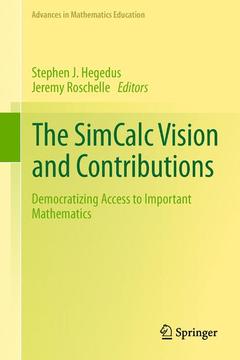Description
The SimCalc Vision and Contributions, 2013
Democratizing Access to Important Mathematics
Advances in Mathematics Education Series
Coordinators: Hegedus Stephen J., Roschelle Jeremy
Language: English
Subjects for The SimCalc Vision and Contributions:
Keywords
Algebra; Algebra-intensive learning; Calculus; Calculus grades 6-13; Classroom Connectivity; Efficacy Trials; Evolution and SimCalc; Graphical Interpretation; Learning and Motivation; Longitudinal impact of SimCalc Curriculum; Mathematics of Chang and Variation (MCV); Multiple Representations; Networks SimCalc; Prof; James Kaput; Prof; Jim Kaput; Randomized Controlled Trials; Rate and SimCalc; Semiotics and SimCalc; SimCalc project; learning and instruction
Publication date: 01-2015
480 p. · 15.5x23.5 cm · Paperback
Publication date: 12-2012
480 p. · 15.5x23.5 cm · Hardback
Description
/li>Contents
/li>Comment
/li>
This volume provides essential guidance for transforming mathematics learning in schools through the use of innovative technology, pedagogy, and curriculum. It presents clear, rigorous evidence of the impact technology can have in improving students learning of important yet complex mathematical concepts -- and goes beyond a focus on technology alone to clearly explain how teacher professional development, pedagogy, curriculum, and student participation and identity each play an essential role in transforming mathematics classrooms with technology. Further, evidence of effectiveness is complemented by insightful case studies of how key factors lead to enhancing learning, including the contributions of design research, classroom discourse, and meaningful assessment.
The volume organizes over 15 years of sustained research by multiple investigators in different states and countries who together developed an approach called "SimCalc" that radically transforms how Algebra and Calculus are taught.
The SimCalc program engages students around simulated motions, such as races on a soccer field, and builds understanding using visual representations such as graphs, and familiar representations such as stories to help students to develop meaning for more abstract mathematical symbols. Further, the SimCalc program leverages classroom wireless networks to increase participation by all students in doing, talking about, and reflecting on mathematics. Unlike many technology programs, SimCalc research shows the benefits of balanced attention to curriculum, pedagogy, teacher professional development, assessment and technology -- and has proven effectiveness results at the scale of hundreds of schools and classrooms.
Combining the findings of multiple investigators in one accessible volume reveals the depth and breadth of the research program, and engages readers interested in:
* Engaging students in deeply learning the important concepts in mathematics
* Designing innovative curriculum, software, and professional development
· Effective uses of technology to improve mathematics education
* Creating integrated systems of teaching that transform mathematics classrooms
* Scaling up new pedagogies to hundreds of schools and classrooms
* Conducting research that really matters for the future of mathematics learning
?
* Engaging students in deeply learning the important concepts in mathematics
* Designing innovative curriculum, software, and professional development
· Effective uses of technology to improve mathematics education
* Creating integrated systems of teaching that transform mathematics classrooms
* Scaling up new pedagogies to hundreds of schools and classrooms
* Conducting research that really matters for the future of mathematics learning
?
?
Shows how to improve learning of important mathematics with technology
Organizes 15 years of rigorous research, including both effectiveness results and pedagogical insights, including contributions from leading researchers through the United States and worldwide
Distills lessons from SimCalc's sustained, visionary program of innovation in one accessible volume
Includes supplementary material: sn.pub/extras
These books may interest you

Mathematics Education in Singapore 158.24 €



